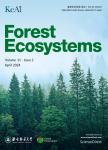Drivers of spatial structure in thinned forests
作者机构:College of Mechanical and Electrical EngineeringNortheast Forestry UniversityHarbin150040China Department of Forest Resources ManagementUniversity of British ColumbiaVancouverCanada
出 版 物:《Forest Ecosystems》 (森林生态系统(英文版))
年 卷 期:2024年第11卷第2期
页 面:202-213页
核心收录:
学科分类:0907[农学-林学] 09[农学] 0903[农学-农业资源与环境]
基 金:financially supported by the Innovation Foundation for Doctoral Program of Forestry Engineering of Northeast Forestry University,grant number:LYGC202117 the China Scholarship Council(CSC),grant number:202306600046 the Research and Development Plan of Applied Technology in Heilongjiang Province of China,grant number:GA19C006 Research and Demonstration on Functional Improvement Technology of Forest Ecological Security Barrier in Heilongjiang Province,grant number:GA21C030。
主 题:Thinning Natural secondary forest Spatial structure Dynamic changes Growth factors Structural equation modeling
摘 要:Background:As is widely known,an increasing number of forest areas were managed to preserve and enhance the health of forest ecosystems.However,previous research on forest management has often overlooked the importance of structure-based.Aims:Our objectives were to define the direction of structure-based forest management.Subsequently,we investigated the relationships between forest structure and the regeneration,growth,and mortality of trees under different thinning treatments.Ultimately,the drivers of forest structural change were explored.Methods:On the basis of 92 sites selected from northeastern China,with different recovery time (from 1 to 15years) and different thinning intensities (0–59.9%) since the last thinning.Principal component analysis (PCA)identified relationships among factors determining forest spatial structure.The structural equation model (SEM)was used to analyze the driving factors behind the changes in forest spatial structure after thinning.Results:Light thinning (0–20%trees removed) promoted forest regeneration,and heavy thinning (over 35% of trees removed) facilitated forest growth.However,only moderate thinning (20%–35%trees removed) created a reasonable spatial structure.While dead trees were clustered,and they were hardly affected by thinning intensity.Additionally,thinning intensity,recovery time,and altitude indirectly improve the spatial structure of the forest by influencing diameter at breast height (DBH) and canopy area.Conclusion:Creating larger DBH and canopy area through thinning will promote the formation of complex forest structures,which cultivates healthy and stable forests.



